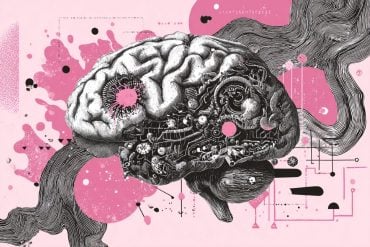Summary: According to researchers, socially contagious itching may be hard wired in the brain.
Source: WUSTL.
Researchers discover why mice scratch in response to other mice scratching.
Some behaviors — yawning and scratching, for example — are socially contagious, meaning if one person does it, others are likely to follow suit. Now, researchers at Washington University School of Medicine in St. Louis have found that socially contagious itching is hardwired in the brain.
Studying mice, the scientists have identified what occurs in the brain when a mouse feels itchy after seeing another mouse scratch. The discovery may help scientists understand the neural circuits that control socially contagious behaviors.
The study is published March 10 in the journal Science.
“Itching is highly contagious,” said principal investigator Zhou-Feng Chen, PhD, director of the Washington University Center for the Study of Itch. “Sometimes even mentioning itching will make someone scratch. Many people thought it was all in the mind, but our experiments show it is a hardwired behavior and is not a form of empathy.”
For this study, Chen’s team put a mouse in an enclosure with a computer screen. The researchers then played a video that showed another mouse scratching.
“Within a few seconds, the mouse in the enclosure would start scratching, too,” Chen said. “This was very surprising because mice are known for their poor vision. They use smell and touch to explore areas, so we didn’t know whether a mouse would notice a video. Not only did it see the video, it could tell that the mouse in the video was scratching.”
Next, the researchers identified a structure called the suprachiasmatic nucleus (SCN), a brain region that controls when animals fall asleep or wake up. The SCN was highly active after the mouse watched the video of the scratching mouse.

When the mouse saw other mice scratching — in the video and when placed near scratching littermates — the brain’s SCN would release a chemical substance called GRP (gastrin-releasing peptide). In 2007, Chen’s team identified GRP as a key transmitter of itch signals between the skin and the spinal cord.
“The mouse doesn’t see another mouse scratching and then think it might need to scratch, too,” Chen said. “Instead, its brain begins sending out itch signals using GRP as a messenger.”
Chen’s team also used various methods to block GRP or the receptor it binds to on neurons. Mice whose GRP or GRP receptor were blocked in the brains’ SCN region did not scratch when they saw others scratch. But they maintained the ability to scratch normally when exposed to itch-inducing substances.
Chen believes the contagious itch behavior the mice engaged in is something the animals can’t control.
“It’s an innate behavior and an instinct,” he said. “We’ve been able to show that a single chemical and a single receptor are all that’s necessary to mediate this particular behavior. The next time you scratch or yawn in response to someone else doing it, remember it’s really not a choice nor a psychological response; it’s hardwired into your brain.
Yu YQ, Barry DM, Hao Y, Liu XT, Chen ZF. Molecular and neural basis of contagious itch behavior in mice. Science, March 10, 2017.
Funding: This work was supported by the National Institute on Drug Abuse, the National Institute of Arthritis and Musculoskeletal and Skin Diseases and the National Institute on Neurological Disorders and Stroke of the National Institutes of Health (NIH), grant numbers: 1R01 AR056318-06, R21 NS088861-01A1, R01 NS 094344, R01 DA037261-01A1, R56 AR064292-01A1, 5T32 DA007261-23. Additional support was provided by a W.M. Keck Fellowship, the Hope Center Viral Vectors Core at Washington University School of Medicine, the M.R. Bruchas Lab.
Source: Jim Dryden – WUSTL
Image Source: NeuroscienceNews.com image is credited to credited to Michael Worful.
Original Research: Abstract for “Molecular and neural basis of contagious itch behavior in mice” by Yao-Qing Yu, Devin M. Barry, Yan Hao, Xue-Ting Liu, and Zhou-Feng Chen in Science. Published online March 10 2017 doi:10.1371/journal.pone.0172531
[cbtabs][cbtab title=”MLA”]WUSTL “Brain Hardwired to Respond to Others’ Itching: Mouse Study.” NeuroscienceNews. NeuroscienceNews, 12 March 2017.
<https://neurosciencenews.com/itch-response-neuroscience-6235/>.[/cbtab][cbtab title=”APA”]WUSTL (2017, March 12). Brain Hardwired to Respond to Others’ Itching: Mouse Study. NeuroscienceNew. Retrieved March 12, 2017 from https://neurosciencenews.com/itch-response-neuroscience-6235/[/cbtab][cbtab title=”Chicago”]WUSTL “Brain Hardwired to Respond to Others’ Itching: Mouse Study.” https://neurosciencenews.com/itch-response-neuroscience-6235/ (accessed March 12, 2017).[/cbtab][/cbtabs]
Abstract
Molecular and neural basis of contagious itch behavior in mice
Socially contagious itch is ubiquitous in human society, but whether it exists in rodents is unclear. Using a behavioral paradigm that does not entail prior training or reward, we found that mice scratched after observing a conspecific scratching. Molecular mapping showed increased neuronal activity in the suprachiasmatic nucleus (SCN) of the hypothalamus of mice that displayed contagious scratching. Ablation of gastrin-releasing peptide receptor (GRPR) or GRPR neurons in the SCN abolished contagious scratching behavior, which was recapitulated by chemogenetic inhibition of SCN GRP neurons. Activation of SCN GRP/GRPR neurons evoked scratching behavior. These data demonstrate that GRP-GRPR signaling is necessary and sufficient for transmitting contagious itch information in the SCN. The findings may have implications for our understanding of neural circuits that control socially contagious behaviors.
“Molecular and neural basis of contagious itch behavior in mice” by Yao-Qing Yu, Devin M. Barry, Yan Hao, Xue-Ting Liu, and Zhou-Feng Chen in Science. Published online March 10 2017 doi:10.1371/journal.pone.0172531






